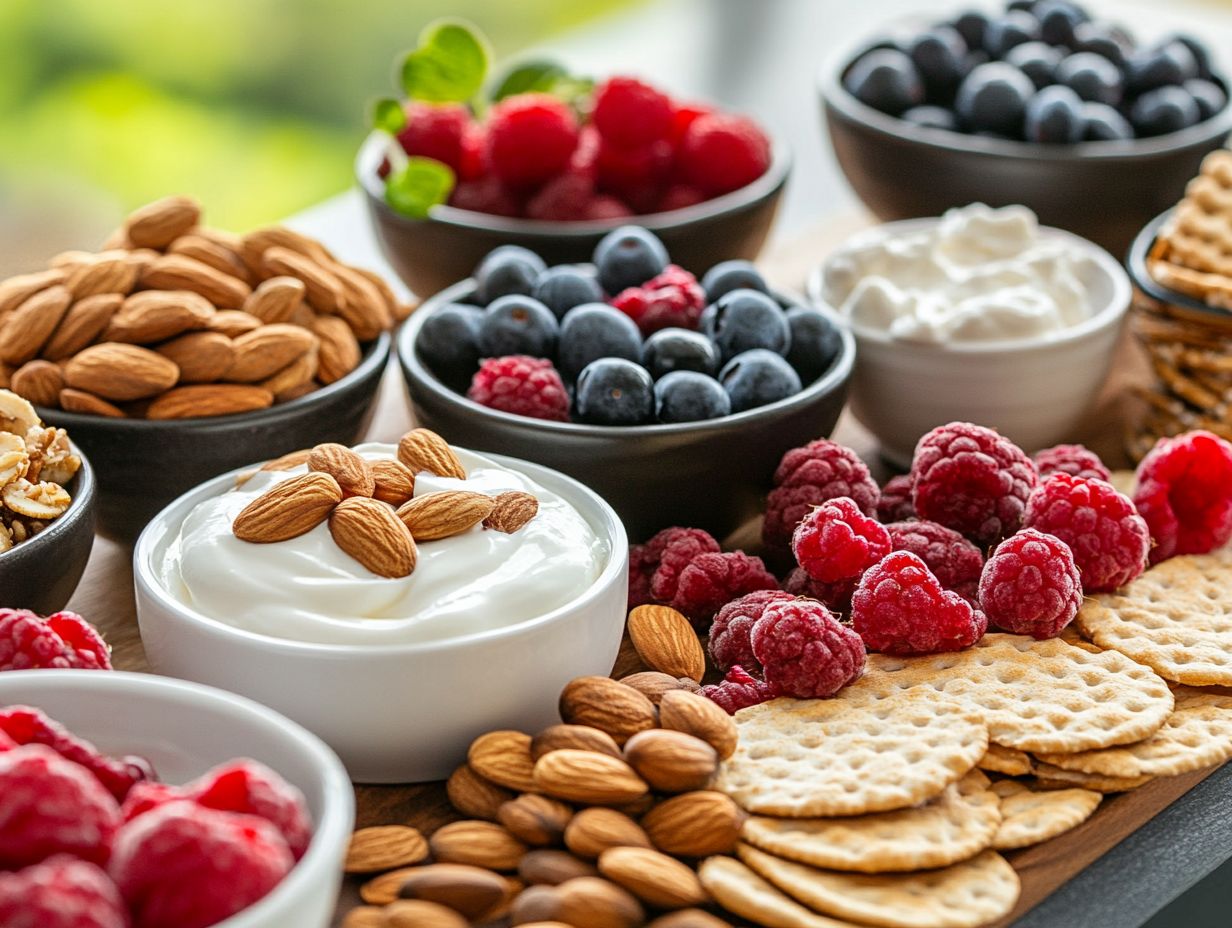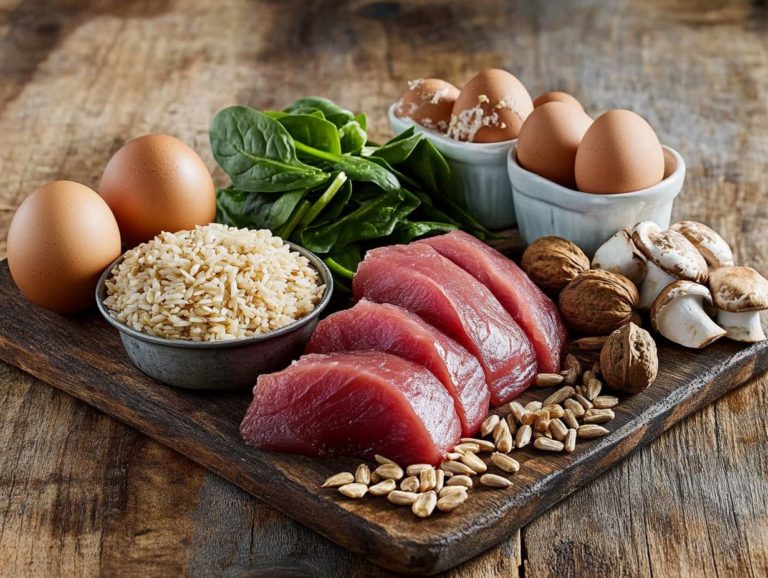How to Identify Nutrient-Rich Snack Options
Snacking can present a maze of choices. Remember, not all snacks are created equal.
This article explores what makes a snack rich in nutrients. You will learn how to spot essential vitamins and minerals and read nutrition labels effectively.
Practical tips and examples of healthy snacks will empower you to make better selections. You’ll also discover satisfying substitutes for those tempting, less healthy cravings.
Prepare to elevate your snacking habits!
Contents
- Key Takeaways:
- Understanding Nutrient-Rich Snacks
- Nutrient-Dense Snack Options
- Identifying Key Nutrients in Snacks
- Reading Nutrition Labels on Snacks
- Incorporating Nutrient-Dense Snacks into Your Diet
- Snack Substitutions for Common Cravings
- Preguntas Frecuentes
- 1. What are nutrient-rich snack options?
- 2. How can I tell if a snack is nutrient-rich?
- 3. Are all fruits and vegetables considered nutrient-rich snacks?
- 4. Are there specific nutrients I should look for in a healthy snack?
- 5. Can protein bars be considered nutrient-rich snacks?
- 6. Can I find nutrient-rich snacks in prepackaged foods?
Key Takeaways:

Choose snacks rich in nutrients. These snacks should contain beneficial vitamins and minerals.
Look for snacks with essential nutrients like vitamins A, C, D, E, and minerals like iron and calcium. Read nutrition labels carefully to find the most nutrient-rich options.
Understanding Nutrient-Rich Snacks
Snacks rich in nutrients offer your family the best options. They should be delicious and packed with health benefits.
These snacks contain essential nutrients like vitamins, minerals, fiber, and protein. They help sustain energy and promote overall health.
As a mother, it s vital to choose enjoyable snacks that support a healthy diet for you and your children, especially on occasions like Mother’s Day.
What Makes a Snack Nutrient-Rich?
A snack is nutrient-rich when it offers a good balance of proteins, carbohydrates, and healthy fats. Look for options filled with vitamins and minerals.
For example, Greek yogurt with fresh berries provides protein, healthy fats, and antioxidant-rich vitamins. You can elevate your family s diet by introducing snacks like:
- Homemade trail mix with nuts, seeds, and dried fruits
- Veggie sticks with hummus
Your children can enjoy these tasty treats while getting essential nutrients.
Nutrient-Dense Snack Options
When you choose nutrient-rich snacks, you open a world of options that align with your family’s dietary needs. You can select only the best snacks available.
Snacks like raw nuts, nut butters, canned tuna, dried fruit, and Good Measure Bars are tasty and packed with essential nutrients. These options fit seamlessly into a busy lifestyle.
Examples of Healthy Snacks
Healthy snacks include options like fresh fruits, raw nuts, whole grain crackers, and yogurt. These choices satisfy cravings while providing essential nutrients.
Incorporating a variety of these snacks into your daily menu helps meet your nutritional needs. They can curb hunger between meals.
- Fresh fruits offer hydration and fiber, which support digestive health and boost your immune system.
- Raw nuts provide healthy fats and protein, enhancing fullness and promoting heart health.
- Whole grain crackers deliver energy-boosting carbohydrates, keeping you alert throughout the day.
- Yogurt, rich in probiotics, supports gut health and helps you feel full.
Remember, portion control is essential. Enjoy these nutritious treats without overindulging!
Identifying Key Nutrients in Snacks

Identifying key nutrients in snacks is crucial for anyone looking to create a nutritious diet for their family.
By understanding the essential nutrients in the foods you select, you enable yourself to make informed choices. Key nutrients like fiber, protein, omega-3 fatty acids, calcium, potassium, zinc, and iron are not just buzzwords; they play vital roles in your overall health.
Recognizing their importance can help you and your loved ones stave off health issues such as type 2 diabetes and heart disease.
Essential Vitamins and Minerals to Look For
When evaluating snacks, seek out essential vitamins and minerals like calcium, iron, potassium, and zinc. These nutrients are key players in creating a balanced, nutrient-dense diet for your family.
These vital components support various bodily functions, from bone development to energy metabolism. For example, calcium is crucial for strong bones and teeth, while iron is necessary for transporting oxygen in the blood.
Potassium helps regulate blood pressure, and zinc plays an important role in wound healing and immune health.
Look for these snack options:
- Yogurt for calcium
- Iron-rich nuts or dark chocolate
- Potassium-packed bananas
- Pumpkin seeds for zinc
By incorporating a vibrant array of fruits, crunchy vegetables, and wholesome grains into your daily snacks, you can inspire healthier choices that satisfy cravings while nourishing the body.
Reading Nutrition Labels on Snacks
Reading nutrition labels on snacks is a critical skill for anyone committed to making informed choices about the healthy options they bring into their home.
These labels provide crucial insights, including calorie content, how much protein, fat, and carbs it contains, and portion sizes.
This knowledge enables you to understand exactly what you re providing for your family, ensuring that your choices align seamlessly with your nutritional goals.
How to Interpret and Compare Labels
Interpreting and comparing labels is essential for making healthy choices. It allows you to assess the nutritional value of different snacks and select the best options for your family.
By taking the time to understand labeling practices, you can easily identify key nutritional elements. Pay attention to fiber content; high-fiber snacks tend to promote better digestion and keep everyone feeling fuller for longer.
Protein levels are also important, as they can indicate whether a snack will provide sustained energy without leading to a sugar spike. And when it comes to sugars, be sure to scrutinize added sugars, which can vary widely and often masquerade under different names.
By comparing labels, you can easily pick healthier snacks for your family and foster better portion control, encouraging a mindful approach to snacking for everyone in your household.
Incorporating Nutrient-Dense Snacks into Your Diet
Incorporating nutrient-dense snacks into your diet can truly transform your approach to enhancing your family’s healthy eating habits. Pair this with smart meal planning, and you’ll see big changes!
By choosing nutrient-dense options and preparing simple, delicious recipes, you can seamlessly weave healthy snacks into your daily routine, ensuring that nutritious choices are always at your fingertips.
Tips for Meal Planning and Snack Choices

Regarding meal planning, adopting a strategic approach enables you to make informed, healthy snack choices that cater to your family’s dietary needs.
By crafting a well-structured weekly menu, you can effortlessly incorporate nutrient-dense snacks that deliver essential vitamins and minerals, keeping your children energized throughout the day.
Achieving this balance requires a touch of flexibility; it allows you to make adjustments based on daily activities and cravings.
When you shop for snacks, prioritize whole foods like nuts, yogurt, and fresh fruit, ensuring they are conveniently portioned for better control.
This approach not only supports a healthy diet but also makes snack time fun and exciting for everyone!
Snack Substitutions for Common Cravings
Discovering healthy snack substitutions for your common cravings is an essential skill for anyone looking to maintain a nutritious diet and lessen reliance on unhealthy snacks, especially processed options.
By choosing healthier alternatives, you can indulge those cravings while ensuring that your family’s nutritional needs are met and their overall well-being is prioritized.
Healthy Alternatives to Unhealthy Snacks
You can easily discover a plethora of healthy alternatives to those common unhealthy snacks, effortlessly elevating your family’s diet.
Swap out those chips for baked whole grain crackers or trade candy for vibrant, fresh fruits.
By making these simple yet impactful changes, you’re not just satisfying cravings. You’re nourishing your family’s bodies with options full of nutrients.
Instead of sugary granola bars, offer a tasty mix of nuts, seeds, and dried fruits for more fiber and healthy fats.
Seasoned popcorn can replace salted snacks, delivering whole grains without any unhealthy additives.
Bring a rainbow of colorful fruits into your home! Your children will love the natural sweetness and get a boost of vitamin C.
These nutritious snacks collectively support energy and overall well-being, laying a solid foundation for healthier eating habits.
Preguntas Frecuentes
Here are some common questions about healthy snacks.
1. What are nutrient-rich snack options?
Nutrient-rich snacks provide a high amount of essential nutrients, such as vitamins, minerals, proteins, and healthy fats, without being high in calories, added sugars, and unhealthy fats.
2. How can I tell if a snack is nutrient-rich?

You can identify nutrient-rich snacks by reviewing their nutrition label. Look for snacks that are high in essential nutrients and low in added sugars, sodium, and unhealthy fats. Also, seek snacks made with whole, unprocessed ingredients.
3. Are all fruits and vegetables considered nutrient-rich snacks?
No, not all fruits and vegetables are considered nutrient-rich snacks. Some, like avocados and dried fruits, can be high in healthy fats and added sugars, which may make them less nutrient-dense. It’s best to choose a variety of fruits and vegetables to ensure a range of essential nutrients.
4. Are there specific nutrients I should look for in a healthy snack?
Yes, when choosing a nutrient-rich snack, it’s important to look for options high in vitamins, minerals, and fiber. These nutrients are essential for overall health and can help you feel fuller for longer.
5. Can protein bars be considered nutrient-rich snacks?
Protein bars can be a good option for a nutrient-rich snack, but it’s important to read the label and choose those low in added sugars and unhealthy fats. Look for bars with a good balance of protein, fiber, and essential vitamins and minerals.
6. Can I find nutrient-rich snacks in prepackaged foods?
Yes, there are many prepackaged snack options that are considered nutrient-rich. Look for snacks made with whole, unprocessed ingredients that are low in added sugars, sodium, and unhealthy fats. Some examples include unsalted nuts, whole grain crackers, and low-fat cheese sticks.






